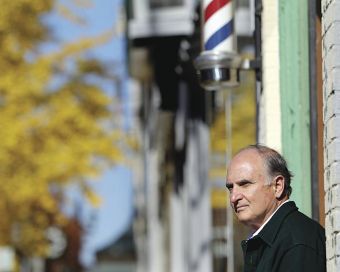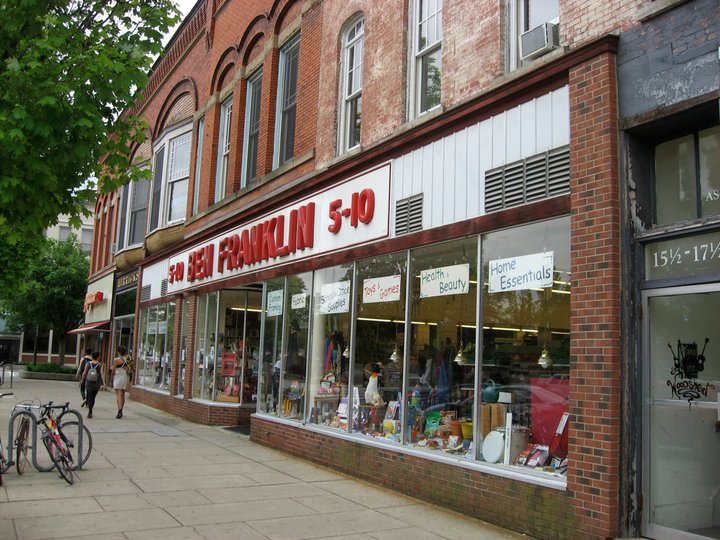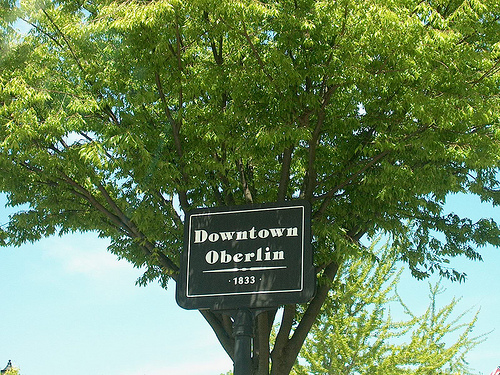 Environmental Studies professor David OrrPhoto: Lisa DeJongThis story is the first of two pieces excerpted from a feature story in the Chronicle of Higher Education. Read part 2 here and the full Chronicle story here.
Environmental Studies professor David OrrPhoto: Lisa DeJongThis story is the first of two pieces excerpted from a feature story in the Chronicle of Higher Education. Read part 2 here and the full Chronicle story here.
Oberlin, Ohio — This northern Ohio college town is barely a blip on a map, far away from national centers of power. And yet people here are working on a plan that could make it a model for fundamentally reshaping the American economy and its society.
The architect of the plan is David W. Orr, a professor of environmental studies and politics at Oberlin College. More than a decade ago, he helped inspire a “green building” trend when he dreamed up the Adam Joseph Lewis Center for Environmental Studies, which remains one of the greenest college buildings in the country. Now he wants to expand that vision to Oberlin and its surrounding area. The Oberlin Project, as it’s called, joins town and college to create a resilient community for a post-fossil-fuel era.
In 2007, Orr was planning to leave Oberlin College, with some bitterness. After the Lewis Center was complete, he felt the college had squandered opportunities to build green and retain a leadership position in sustainability. Marvin Krislov, a former general counsel at the University of Michigan at Ann Arbor, became president that year, and he asked Orr what might keep him on campus.
What Orr came back with — and what Oberlin’s city government and the college’s administrators and Board of Trustees eventually supported — was the Oberlin Project. A “green arts district” would catalyze a green redevelopment of the city and surrounding area as a whole. The outdated Oberlin Inn would be replaced by a new hotel, bars and restaurants, a conference center, student residences, facilities for the college’s arts programs, and a sustainable-design center. Those facilities would employ local craftsmen and use local products in their construction, kick-starting a local wood-products industry.
 Photo: Scott CarlsonThe college dining services and restaurants would get their food from a 20,000-acre greenbelt in the region — Orr is working with the Western Reserve Land Conservancy to identify a patchwork of Ohio farms that might be willing to give up some commodity crops to grow more vegetables for the city. Students from the local vocational school, which has a top-notch culinary program, would work in the conference center and restaurants. All the sewage would run through a Living Machine — a system that uses plants and microbes to clean wastewater.
Photo: Scott CarlsonThe college dining services and restaurants would get their food from a 20,000-acre greenbelt in the region — Orr is working with the Western Reserve Land Conservancy to identify a patchwork of Ohio farms that might be willing to give up some commodity crops to grow more vegetables for the city. Students from the local vocational school, which has a top-notch culinary program, would work in the conference center and restaurants. All the sewage would run through a Living Machine — a system that uses plants and microbes to clean wastewater.
The project unfurls from there, with details changing as Orr makes new deals and dreams up bigger plans. Most recently, he said that the Great Lakes Brewing Company, in Cleveland, had stepped forward with an interest in setting up a brewpub in the green arts district. Orr scrapped his plans for setting up a Living Machine in town. Instead, he said, why not build a sewage digester at the town’s wastewater-treatment plant to produce methane for electricity?
“Every time I have a wild idea, I go down to City Hall and talk to [the city manager] Eric Norenberg and find Marvin Krislov and figure out how we can do it,” Orr says.
His challenge always lies in strategizing ways to sell the project, so he works it from different angles: If he is talking to fellow academics, he plays up the new facilities and the educational opportunities. If he is talking to an Oberlin business owner, he discusses the buzz and drawing visitors to the city.
Observers say one of the project’s main risks is that it could be perceived as an effete, academic endeavor. Andy McDowell, a field director with the Western Reserve Land Conservancy who is helping Orr establish the greenbelt, doesn’t mention climate neutrality or use the term “greenbelt” when talking to conservative farmers outside Oberlin. They are already skeptical of the intellectuals’ ideas in town.
“It has to focus on economic stability, growing our local economies, and food security,” McDowell says. “Those are the kinds of things that are going to resonate once it gets beyond this bubble.”
Kenneth Sloane, president of the city council, who counts himself as a friend of Orr’s, says that Oberlin suffers from community-school tensions as much as any college town, but that on the streets, people are generally positive about Orr’s ideas. “People here are embracing the project because they hope it will be an economic generator,” he says. “If doom and gloom hit the international economy, if we have developed a local network of industry and farming that is sustainable, we could be self-sufficient.”
No doubt Orr faces significant hurdles. The project may evolve over decades, and at a time when money is tight and philanthropy is a tough game, an early estimate pegs the project’s cost at about $140-million — with $55 million just to complete the first phase. (So far the professor has raised $9 million toward his lofty goal. He predicts that most of the money will come from private investment, philanthropy, tax credits, and bonds.) And it’s fair to wonder whether the plan can maintain its momentum, particularly without Orr, who at 67 may not see the project to its end.
Still, Krislov, Oberlin’s president, says the project could pay off — and not just by making the college more attractive to prospective students. “It shows that an aging town in the Rust Belt can in essence reinvent itself, drawing on its strengths in education and the arts, with a commitment to sustainability,” Krislov says. To make things even more interesting, he says, “We are not doing this in a new city, a new area, or a growth area, but in an area that is experiencing decline.”
Next: Why the Oberlin Project is getting support from military brass.



